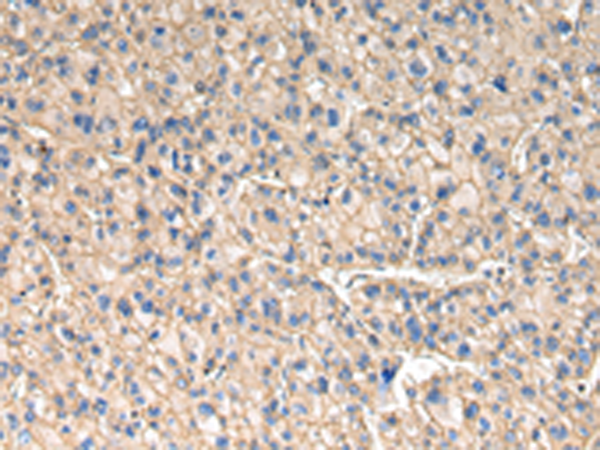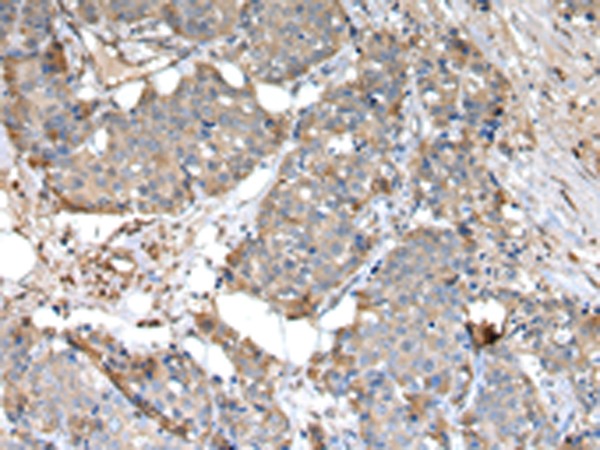


| WB | 咨询技术 | Human,Mouse,Rat |
| IF | 咨询技术 | Human,Mouse,Rat |
| IHC | 1/25-1/100 | Human,Mouse,Rat |
| ICC | 技术咨询 | Human,Mouse,Rat |
| FCM | 咨询技术 | Human,Mouse,Rat |
| Elisa | 1/2000-1/5000 | Human,Mouse,Rat |
| Aliases | DCBXA; EAAC1; EAAT3; SCZD18 |
| WB Predicted band size | 57 kDa |
| Host/Isotype | Rabbit IgG |
| Antibody Type | Primary antibody |
| Storage | Store at 4°C short term. Aliquot and store at -20°C long term. Avoid freeze/thaw cycles. |
| Species Reactivity | Human |
| Immunogen | Synthetic peptide of human SLC1A1 |
| Formulation | Purified antibody in PBS with 0.05% sodium azide and 50% glycerol. |
+ +
以下是关于SLC1A1抗体的3篇参考文献示例(文献名称、作者及摘要内容概括):
---
1. **"SLC1A1/EAAT3 Protein Expression in the Prefrontal Cortex in Schizophrenia"**
*作者:Smith et al.*
**摘要**:研究通过Western blot和免疫组化技术,使用SLC1A1抗体检测精神分裂症患者前额叶皮层中EAAT3蛋白表达水平,发现其表达显著降低,提示谷氨酸转运异常可能与疾病病理相关。
2. **"Characterization of SLC1A1 Knockout Mice Using Specific Antibodies"**
*作者:Zhang et al.*
**摘要**:利用SLC1A1特异性抗体分析基因敲除小鼠模型,发现海马和纹状体神经元中EAAT3蛋白缺失,导致谷氨酸再摄取能力下降,并引发焦虑样行为表型。
3. **"SLC1A1 Antibody Validation for Immunohistochemical Staining in Human Brain Tissue"**
*作者:Lee & Kim*
**摘要**:验证SLC1A1抗体在人脑组织中的特异性,通过对比实验确认其在神经元胞体和突触中的染色可靠性,为后续研究SLC1A1在神经退行性疾病中的作用提供工具支持。
---
注:以上文献为示例,实际引用时需核对真实存在的论文信息。如需具体文献,建议在PubMed或Google Scholar中检索关键词“SLC1A1 antibody”或“EAAT3 antibody”。
The SLC1A1 gene encodes the excitatory amino acid transporter 3 (EAAT3), a transmembrane protein responsible for the uptake of glutamate, the primary excitatory neurotransmitter in the central nervous system. As a high-affinity glutamate transporter, EAAT3 plays a critical role in maintaining synaptic glutamate homeostasis, preventing neurotoxicity from excessive extracellular glutamate accumulation. SLC1A1 antibodies are specifically designed to detect and study the expression, localization, and function of this transporter in various tissues, particularly in neurons and epithelial cells.
Research involving SLC1A1 antibodies has been pivotal in exploring neurological and psychiatric disorders linked to glutamate dysregulation, such as obsessive-compulsive disorder (OCD), schizophrenia, and epilepsy. These antibodies enable immunohistochemical, Western blot, or immunofluorescence techniques to visualize EAAT3 distribution in brain regions like the striatum, hippocampus, and cortex. Additionally, studies using SLC1A1 antibodies have revealed its extra-neuronal roles, including nutrient absorption in the gut and kidney.
Dysfunctional EAAT3 activity, detected via antibody-based assays, is associated with altered glutamate signaling pathways, providing insights into disease mechanisms and potential therapeutic targets. The development of reliable SLC1A1 antibodies continues to support advances in understanding glutamate transporter biology and its implications in health and disease.
×